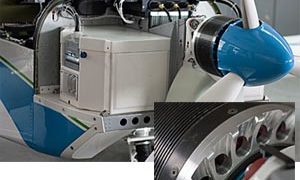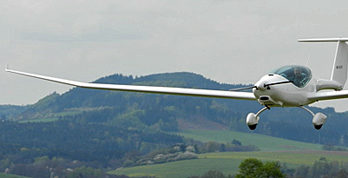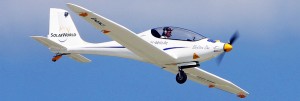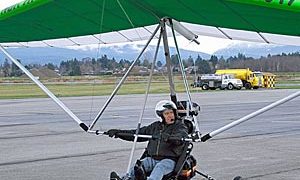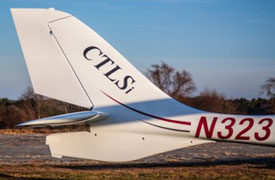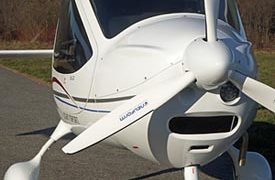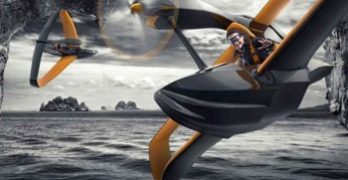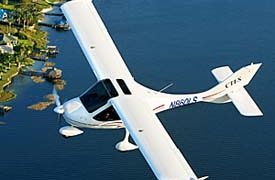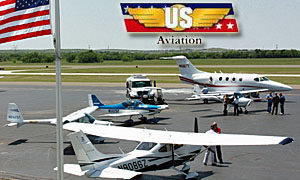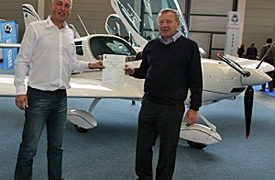An “engine” is a machine distinguished from an electric, spring-driven, or hydraulic motor by its use of a fuel, by which most mean gasoline or diesel fuel. An electric powerplant is often referred to as a motor to make it distinct although “motor” is defined as a device that converts any form of energy into mechanical output, which would include engines.
Without fretting over the definition, Evektor flew their new “motorplane” (my word) recently and this post presents our view of this accomplishment. We’ve reported several electric aircraft projects, for example, Yuneec’s Spyder and their larger e430 mentioned in my full-length article on electric aircraft. We’ve also covered Randall Fishman’s ULS (which will be on display in the LSA Mall at Sun ‘n Fun) and several others. To read all our 37 articles of coverage, type “electric aircraft” in the Full-text Search box on our Search page.
Search Results for : flight design ct
Not finding exactly what you expected? Try our advanced search option.
Select a manufacturer to go straight to all our content about that manufacturer.
Select an aircraft model to go straight to all our content about that model.
Long, Lovely Wings … Even Longer Flight
I think Phoenix is one the loveliest aircraft in the LSA fleet. Of course, I have a rather large bias as I’m a soaring enthusiast and this is one fine soaring machine in the SLSA fleet, able to compete fairly with a pure glider. I’m also a fan of importer Jim Lee, a modest, soft spoken man with a deep honesty streak. He’s also a world-renown soaring champion. Yet what just catches my eye again and again are the long, lovely, shapely, slippery wings of Phoenix, which lead me to present the photos you see with this article.
These views came from Jim’s long flight from his home base not far from mine in Melbourne, Florida to Bogota, Columbia. That meant a long water crossing from Key West to the Mexican coast, then south to Belize and on around to his destination (see route map). Jim wrote a blog of this entire experience featuring many photos and I’ll bet most pilots would like to read it.
Electric Airplane in 48 hours!
With all the bright minds drilling down for electric flight gold worldwide these days, including extensive research into battery storage technology and electric motor development, you’d think it’s only a matter of time before a major aircraft company comes out with an off-the-shelf aircraft to officially “launch” electric flight for the masses.
Yuneec, a Chinese company, did just that a few years back with its graceful E430. Several other companies debuted exciting electric prototypes yet since then, little has manifested under the pilot’s Christmas tree beyond a $200,000-plus electric-sustained sailplane (the elegant Lange Aviation Antares 20E), a composite motorgliderish single-seater that goes for around $140,000 (PC Aero Elektra One) and a two-seat, side-by-side electric powered sailplane (Pipistrel Taurus Electro G2, also available gas powered.)
Of course, we can’t overlook pioneer Randall Fishman‘s efforts.
Canada’s First Electric-Powered Ultralight
From the land of sky-blue waters comes … no, not a beverage but Canada’s first electric ultralight. And sky-blue waters aren’t the point; instead, it’s all about blue skies and getting up to them for a bit of soaring fun. Thanks to my journalist friend Russ Niles, Editor-in-Chief of AvWeb (one of my favorite aviation websites), I heard about a Canadian friend who’s done some interesting development work. Given the general excitement about electric power and my personal interest in soaring flight, I called up my old friend.
Like many of us who enjoy soaring hang gliders, developer Randy Rauck said, “I always wanted to apply electric to a lightweight trike so we could quickly and easily fly our hang gliders up to where the thermals abound.” When he’s not creating a new powerplant Randy runs the Freedom Flight Park in Lumby, BC Canada. “I wanted to try electric to get away from the vibration of a lightweight two-stroke gasoline engine.
CTLSi, as in *sigh*
Yes, as the pics show, I did indeed take advantage of a rare, calm, beautiful, warm (for winter) day in New England to drive over to Tom Peghiny‘s Flight Design USA and take my first hop in a fuel-injected Rotax-powered LSA: the new CTLSi. Company Chief Pilot Jonathan Carter did me the honors as we went for a spin the last hour of the clear-sky, gorgeous day: no bumps, no ATC to deal with, just that good smooth, strong CT climb up and away from the company’s little paved strip in Woodstock, Connecticut.
CTLSi, latest version of the industry-leading CT line (the company’s been at the front of the pack for 7 years), is noteworthy primarily for its new powerplant, which dramatically improves fuel economy, starts easier, and runs smoother. I’ll have a full flight report on the airplane in the spring issue of the magazine. But I don’t want to wait to say that for me, this is a wonderfully refined airplane and a real step forward from the version I flew four years ago when I got my Sport Pilot rating with instructor rock ‘n rollin’ CFI John Lampson (he moonlights with a popular rock band, Stealing Jupiter, in the Northeast).
iLSA & CTLSi — Much More than Fuel Injection
The first iLSA are flying in the USA. Springboarding from Apple’s famous iDevices, why not iLSA? This stands for “i” Light-Sport Aircraft, meaning they’re fuel injected, which today suggests Rotax’s new 912 iS engine. Tecnam has announced P2008s with the new powerplant. Pipistrel has iS models, too. Others will follow, although Remos indicated they are taking a wait-and-see approach to the new powerplant. All models remain available with the carbureted version of the 912s in 80 or 100 horsepower. (See this earlier article about the newest Rotax and this one with a video.)
Market leader Flight Design has iLSA arriving in all corners of the country under the slightly changed name of CTLSi. Flight Design USA president Tom Peghiny recently assembled a couple of these airplanes and logged several flights on them. He offered a series of comments on how his newest LSA is an improvement in last year’s model.
Flynano Makes First Flight!
This is pretty cool, I have to say: a flying…what, waterbike? Winged pontoon? Powered box kite? Here’s the home page for *** Flynano: and doesn’t this supremely giddy pilot in the illustration remind you of U2′s Bono? Hmmm…backer? Person of Interest? Is Lindsay Lohan going to buy one? Stay tuned… *** A year ago, I wrote about these enterprising and clever folks behind the Flynano project. They made a (cue: drum roll) big splash at Europe’s 2011 Aero show when they introduced the mockup. Frankly, I confess to a tad of private skepticism: it looked like a long shot to ever fly, let alone actually come to market. That’s why I try to curb my public expressions of criticism: it’s so easy to be proven wrong. *** I was concerned that although the boxwing concept — a joined upper/lower wing, tailless design — has been proven, (and even marketed in Europe as the Sunny Boxwing, see video at bottom), the Flynano could easily have been just another blue-sky, briefly-ballyhooed project, like so many that have come down the pike (do the name Moeller Aircar ring a familiar note?) *** Yet how cool indeed ‘twould be if this easy-fly skimmer-bug of a recreational aircraft that only operates from the water could actually fly?
Flight School Dilemma… One Solution
Anyone who has tried to borrow money in the last five years knows how tough it has become. Banks supported by government guarantees practically gave money away before the subprime meltdown but are now being much more careful. That’s a good thing but it means even some credit-worthy customers can’t get the loan they need. Commonly rejected are flight schools. Flight training enterprises across the nation are struggling to obtain financing to buy new aircraft to replace aging fleets of trainers.
*** Despite the challenges, one LSA outfit has found at least a partial answer. Thanks to a solid customer (and onetime dealer), Flight Design USA has been able to offer a limited number of schools a method called leaseback. Training students today are three leased back CTLS Light-Sport Aircraft but this business success is only one part of a genuine human interest story.
*** “We are pleased to announce the third CTLS leased to a flight school was used by Iraq war veteran Adam Kisielewski, an Able Flight scholarship recipient who recently earned his Sport Pilot certificate,” said Tom Peghiny of Flight Design USA.
A Tale of Two Flight Schools…
Flight schools —- like many private buyers — are hyperfocused on, “What does an aircraft cost to operate?” Busy flight schools operating at high volume simply must track how all the pennies add up. In this article we asked US Aviation’s Scott Severen for info (based on an earlier post). Why US Aviation? While much of aviation has been down in the dumps, this Texas operation has been growing rapidly. Everybody is else down. They’re up. How to explain? Could it be the company’s willingness to embrace change?
*** “Many factors drive the operational experience and maintenance costs in flight school,” wrote Scott. “If a facility is set up for a particular type of aircraft, with flight instructors knowing the aircraft intimately, with experienced mechanics well trained in the upkeep of that aircraft, and a parts department with well-established suppliers, then you can create a business model to work very efficiently.
EASA Awards First Two Restricted Type Certificates
On Day 1 of Aero 2012, Dave Unwin reported hearing many comments about EASA’s halting move toward acceptance of the concept of SP/LSA, which was invented in the USA. The European Union, with an equally proud heritage of aviation, is showing familiar reluctance to embrace what another country has achieved, even when aircraft builders in the EU seek a one-for-one alignment of the rules so that aircraft certified in one country can be sold in another… as happens now with (most) European airplanes being accepted in the USA. *** While the slow-motion drama continues to unfold, EASA is moving ahead with its DOA/POA/TC approach requiring Design and Production Organization approval and a Type Certificate. *** Some companies have seen that a faster way to enlarging their market is to accept EASA’s more burdensome method. They sought to meet the DOA/POA/TC requirements and on Day 1 at Aero, the first two type certificates were awarded.
- « Previous Page
- 1
- …
- 14
- 15
- 16
- 17
- 18
- …
- 145
- Next Page »


